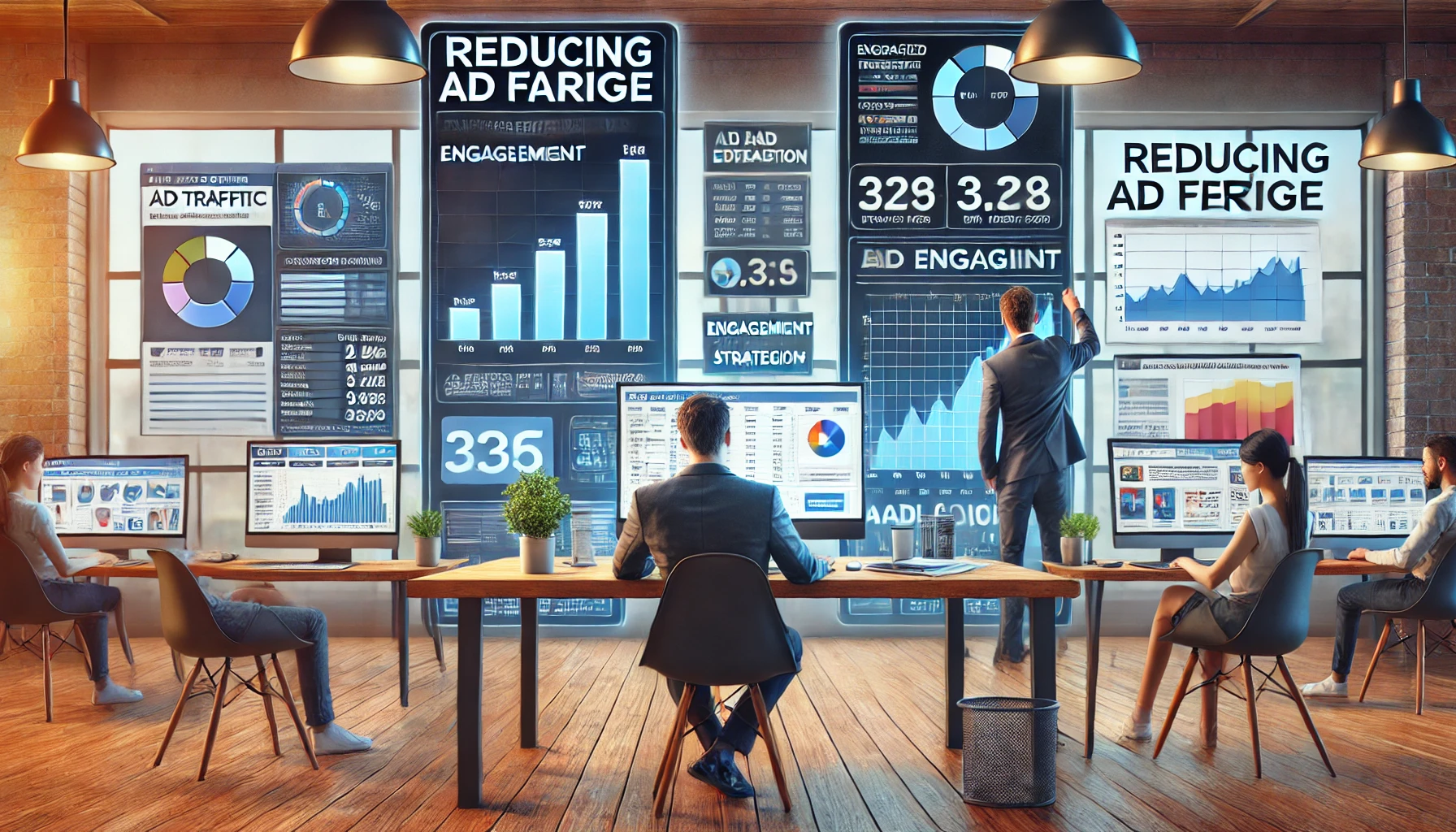Ad fatigue is a common problem in paid traffic campaigns. Over time, audiences see the same ads repeatedly, leading to lower engagement, higher CPC (Cost Per Click), and declining conversions.
If ad fatigue isn’t managed properly, your campaign costs will increase while performance drops—resulting in wasted ad spend.
In this guide, you’ll learn how to prevent and reduce ad fatigue to keep your paid traffic campaigns profitable.
1. What is Ad Fatigue and How Does It Affect Paid Traffic Campaigns?
📌 Ad Fatigue = When audiences see the same ad too often, causing them to ignore or disengage.
✅ Signs of Ad Fatigue:
✔ Declining CTR (Click-Through Rate) – Fewer people are clicking on your ads.
✔ Higher CPC (Cost Per Click) – You’re paying more for the same results.
✔ Increased Frequency Score – Users are seeing your ad too often.
✔ Lower Conversion Rates – Fewer leads or sales from your ads.
💡 Pro Tip: If CTR drops by 30% or more while CPC rises, ad fatigue is likely the issue.
2. Monitor Ad Frequency to Detect Fatigue Early
📌 Ad Frequency = The average number of times a user sees your ad.
✅ Ideal Frequency Benchmarks:
✔ Facebook & Instagram Ads: Keep frequency below 3 for cold audiences, below 6 for retargeting.
✔ Google Display Ads: Keep frequency below 5.
✔ YouTube Ads: Keep frequency below 4 for skippable video ads.
💡 Pro Tip: If frequency gets too high, refresh your creatives or expand your audience.
3. Rotate Ad Creatives Regularly
📌 Using the same ad for too long leads to lower engagement.
✅ How Often to Refresh Ads:
✔ Cold Audiences: Every 2-4 weeks.
✔ Retargeting Audiences: Every 4-6 weeks.
✔ High-Spend Campaigns: Every 7-14 days.
✅ How to Keep Ads Fresh:
✔ Change headlines & descriptions.
✔ Use different images or videos.
✔ Try new CTA variations.
✔ Test different ad formats (carousel, slideshow, video ads, etc.).
💡 Pro Tip: Use Dynamic Creative Ads (Facebook Ads Manager) to automatically rotate images, headlines, and CTAs.
4. Expand and Diversify Your Target Audience
📌 A small audience = faster ad fatigue.
✅ How to Prevent Fatigue with Audience Expansion:
✔ Increase Audience Size → Test Lookalike Audiences (1%-3%) or broader age groups.
✔ Use Exclusions → Remove users who already converted.
✔ Segment Audiences → Show different ads to new users vs. engaged users.
✔ Use Multiple Platforms → Run ads on Facebook, Google, TikTok, LinkedIn, and YouTube instead of relying on one platform.
💡 Pro Tip: If frequency is above 5, expand your audience or change ad targeting.
5. Test Multiple Ad Formats to Keep Users Engaged
📌 Showing the same type of ad over and over increases fatigue.
✅ Best Ad Format Variations to Test:
✔ Static Image Ads → Carousel Ads (Facebook, Instagram).
✔ Single Video Ads → Slideshow Ads (TikTok, YouTube, Facebook).
✔ Text-Based Ads → GIFs & Animated Ads (Google Display, LinkedIn).
✔ Regular Facebook Ads → Messenger Ads (Direct engagement).
💡 Pro Tip: Video ads typically have lower CPC than image ads—test videos to keep engagement high.
6. Use Sequential Retargeting Instead of Repeating the Same Ad
📌 Retargeting the same audience with identical ads = faster fatigue.
✅ How to Set Up Sequential Retargeting:
✔ Day 1-3: Show an educational video ad.
✔ Day 4-7: Retarget viewers with a testimonial or case study ad.
✔ Day 8-14: Show a strong CTA (discount, free trial, webinar invite, etc.).
💡 Pro Tip: Facebook and Google allow custom time-based retargeting—use it to keep ads fresh.
7. Limit Ad Frequency with Automated Rules
📌 Manually checking ad frequency every day is time-consuming—use automation instead.
✅ How to Set Frequency Capping:
✔ Facebook & Instagram: Use “Automated Rules” to pause ads when frequency hits 5+.
✔ Google Ads: Set a “Frequency Cap” (e.g., 3 views per user per week).
✔ TikTok Ads: Adjust delivery frequency settings to avoid overexposure.
💡 Pro Tip: If frequency gets too high, refresh creatives or lower bids.
8. Use Audience Exclusions to Prevent Repetitive Targeting
📌 Retargeting users who already converted wastes budget and creates fatigue.
✅ What to Exclude:
✔ People who already purchased your product.
✔ Leads who signed up for your offer.
✔ Users who haven’t engaged with your ads in 30+ days.
💡 Pro Tip: Update audience exclusions weekly to prevent unnecessary ad spend.
9. Optimize Ad Bidding to Prevent Overexposure
📌 High bids force platforms to show your ad more frequently, leading to fatigue.
✅ How to Optimize Bidding:
✔ Switch to Target CPA or Maximize Conversions instead of Manual CPC.
✔ Reduce bids by 10-20% if frequency is rising too fast.
✔ Use Automated Bid Adjustments (lower bids for users who’ve seen the ad 3+ times).
💡 Pro Tip: Lowering bid limits on high-frequency ads can slow down ad fatigue while maintaining performance.
10. Monitor and Refresh Your Offers to Maintain Interest
📌 If your ad offer never changes, users will start ignoring it.
✅ How to Keep Offers Fresh:
✔ Rotate different incentives (discounts, free trials, exclusive bonuses).
✔ Use seasonal promotions (e.g., Black Friday, Summer Sales).
✔ Test limited-time deals to create urgency.
💡 Pro Tip: Adding a countdown timer or “Only X spots left” message boosts urgency and engagement.
Final Thoughts: Reducing Ad Fatigue & Keeping Campaigns Profitable
Ad fatigue is a major challenge in paid traffic campaigns, but with proper creative rotation, audience expansion, and frequency control, you can keep engagement high and costs low.
📌 Key Takeaways:
✅ Monitor Ad Frequency – Keep it below 3-5 to prevent overexposure.
✅ Rotate Creatives Every 2-4 Weeks – Change images, headlines, and formats.
✅ Expand Target Audiences – Use Lookalike Audiences & interest segmentation.
✅ Test New Ad Formats – Carousel, video, slideshow, Messenger ads, etc.
✅ Use Sequential Retargeting – Show different ads at different stages.
✅ Set Frequency Caps – Use automation to pause high-frequency ads.
✅ Update Offers Regularly – Keep incentives fresh to maintain interest.
🚀 Now it’s your turn! Apply these strategies and prevent ad fatigue while keeping your paid traffic campaigns profitable and engaging!




